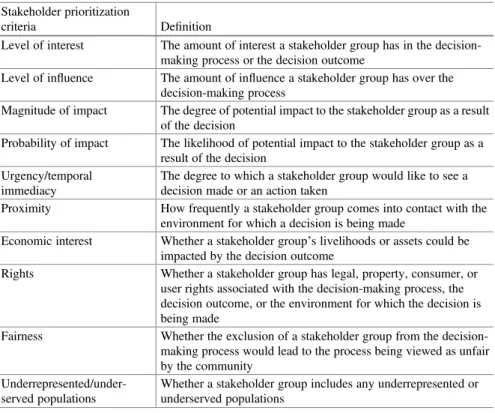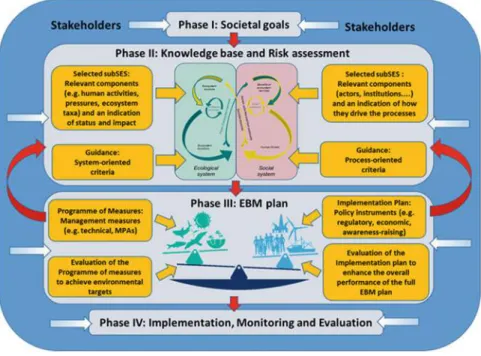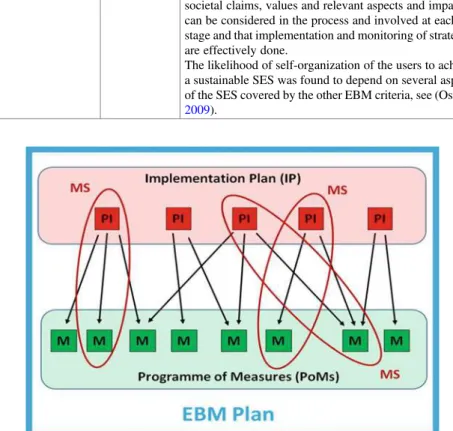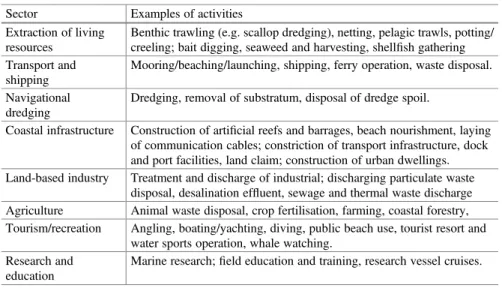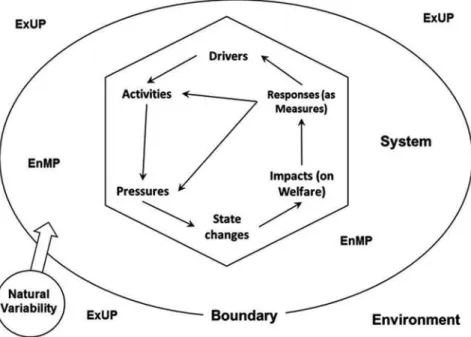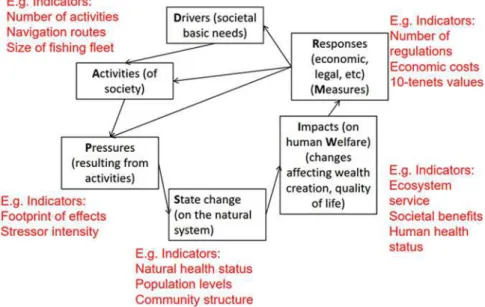DeWitt (ed.), Ecosystem-Based Management, Ecosystem Services and Aquatic Biodiversity: Theory, Tools and Applications (pp. 499-516). DeWitt (ed.), Ecosystem-Based Management, Ecosystem Services and Aquatic Biodiversity: Theory, Tools and Applications (pp. 17-38).
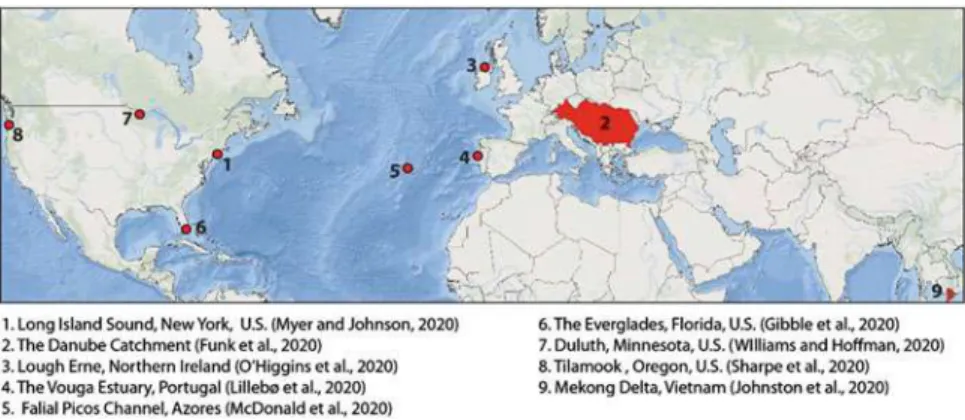
Phase I: Identi fi cation of Societal Goals
Fig.1) to form the knowledge base and by providing practical guidance that enables an evaluation of progress. We assess progress in the development of the knowledge base by looking at the key principles of EBM according to Long et al. 2015) and their alignment with relevant concepts such as IEA (Levin et al.
Phase II: Setting up the Knowledge Base and Conducting a Risk Assessment
With the structure of the knowledge base established, we can consider the three IEA steps: (1) development of ecosystem indicators; (2) identification of reference levels; and (3) conducting risk analyzes (Levin et al. 2014). Variation in the ecological component of SES (eg due to disturbance) should be considered.
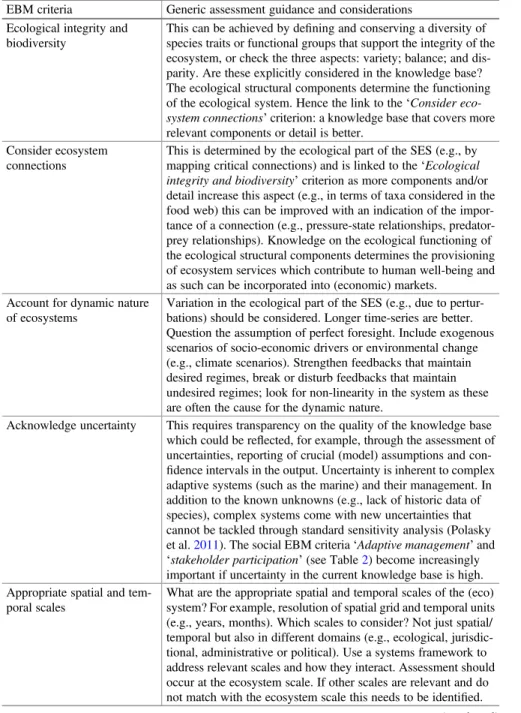
Phase III: Planning of EBM
Since compliance with the SES aspect is a requirement; stakeholder involvement in policy implementation can be instrumental. The design step of the EBM plan begins with the selection of appropriate candidate management measures.
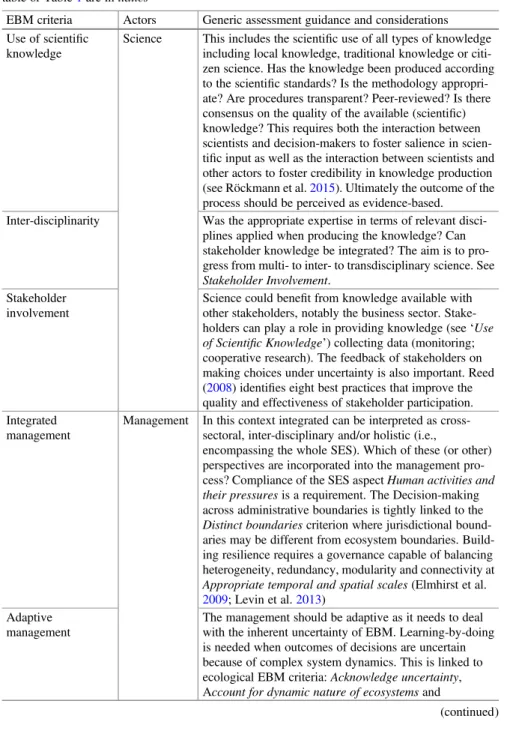
Phase IV: Implementation, Monitoring and Evaluation
An integrated risk-based assessment of the North Sea to guide ecosystem-based management. The science of the whole environment. Experiences from developing integrated ecosystem assessments to inform marine ecosystem-based management in the United States. ICES Journal of Marine Science.
The Many-Sided De fi nition of Ecosystem-Based Management
This makes EBM highly relevant to maintain and restore connections between social and ecological systems (Keesstra et al.2018). EBM is also a way to address uncertainty and variability in ecological systems (Link et al.2012) which are dynamic by definition (DeFries and Nagendra2017).
Disambiguation of the Concept
In fact, these approaches can support the implementation of EA in different biomes (Gómez et al.2016). In fact, EBM is closely related to the notion of meta-ecosystems (Loreau et al. 2003).
Moving Away from Conventional Praxis in Ecosystem Management
Adaptive Governance of Aquatic Ecosystems
DeWitt (Eds.), Ecosystem-based management, ecosystem services, and aquatic biodiversity: Theory, tools, and applications (pp. 333–352). DeWitt (Eds.), Ecosystem-based management, ecosystem services, and aquatic biodiversity: Theory, tools, and applications (pp. 373–402).
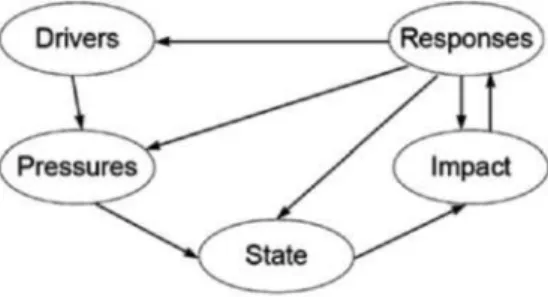
Activities (A)
The latter requires the need to discover the spatial and temporal effects of each Activity, which are much more difficult to determine (Elliott et al. 2018). Here, the Linkage Framework methodologies (Culhane et al. 2020) can be valuable to understand and resolve activities and their resultant pressures.
Pressures (P)
State or State Changes (S)
Primary production Larval and gamete supply Nutrient cycling Water cycling Formation of: species habitat physical barriers oseascape Biological control Natural hazard regulation Waste decomposition and detoxification Carbon sequestration Final services Coastal and marine biota Climate regulation Natural hazard protection Water clean and sediments Lands and sea
Impact (I) (on Human Welfare)
In addition, given the benefits we derive from the sea and coastline, as a result of human activities and pressures this part of the framework reflects any adverse changes affecting blue growth and thus the blue economy as defined above. As such, there is a need for operational indicators of impacts (on human well-being) to show the impact of harmful activities and assets valued by society (Turner and Schaafsma2015).
Response (R) (as Management Measures)
Ecosystem services and social goods and benefits are the key emergent outcomes of the interaction between ecological and socioeconomic systems (Biggs et al. 2012). Managing the marine environment: Integrating ecosystem services and societal benefits with the DPSIR framework in a systems approach.Marine Pollution Bulletin.
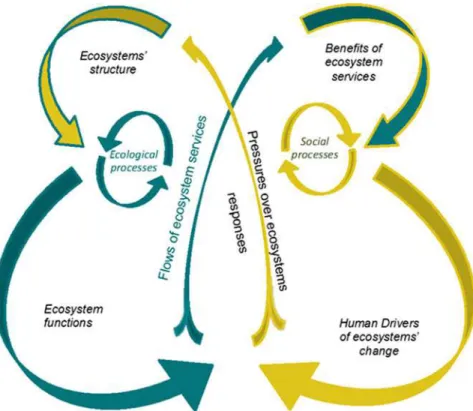
Climate and Biodiversity Crises and the Need for Change
Yet research on the value of ecosystem services reveals that ecosystem services contribute more than twice as much to human well-being as global GDP (Costanza et al. 2014) and greater investment in restoring and protecting the ecosystems and habitats that make these services possible can increase resilience to climate change. It also states with high confidence that short-term actions to promote sustainable land management will help reduce land and food-related vulnerabilities, provide both short-term positive economic returns and long-term benefits for climate change adaptation and mitigation, biodiversity and ecosystem improvement. features and services.
Ecological Damage as an Externality
Figure 1 shows the fundamental differences between ecological economics and traditional neo-classical economic approaches, in terms of their view of the environment, economy and humanity (Flood 2012). Ecological economics takes a more holistic approach and views the economy as a part of humanity living within its environment.
Traction: ESS as a Discipline in Its Own Right
This practical challenge was met by the development of the Final Ecosystem Goods and Services (FEGS) concept. As with other classification systems, the supporting services of the Millennium Ecosystem Assessment have been dropped and are now incorporated as regulatory and maintenance services.
Challenge of Valuation
Economists tend to focus only on FEGS and beneficiaries, whereas ecological researchers with an interest in ecosystem services tend to focus on the full range of services, reflecting their interest in the functioning of ecosystems as a whole and the purpose of the analysis, whether speak of simple accounting. or to justify actions to maximize specific services. s. The price change is then a measure of the value of the ecosystem services one benefits from, just like a price increase due to the establishment of a nature reserve in the neighborhood.
Stated Preference- Methodological Advances and Subtleties
However, empirical work comparing the changes in individual well-being caused by pollution with house prices has shown that they do not necessarily reflect local changes in environmental quality (Rehdanz and Maddison 2008; Spangenberg and Settele 2010). The potential of big data to contribute to the body of information about human recreational use patterns is beginning to improve the capacity to tailor economic valuation studies to specific locations (Adamowicz et al.2011).
Splitters and Lumpers: Real World Complexity, Bundling and Its Implications
Scale and Polycentric Governance
Include Biodiversity and Ecosystem Services (BES) information as part of an iterative Science-Policy process;. DeWitt (ed.), Ecosystem-Based Management, Ecosystem Services and Aquatic Biodiversity: Theory, Tools and Applications (pp. 275–290).
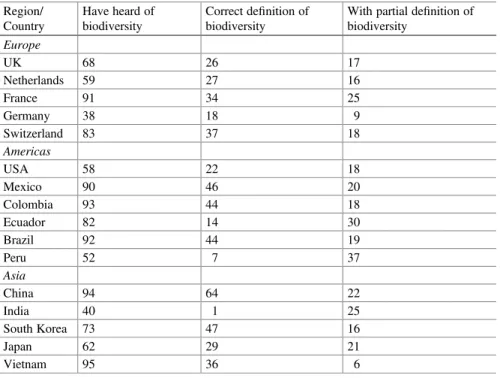
Ecosystem Services Concept
Global strategies tackling these challenges include those based on blue growth, biodiversity and climate change. CICES was primarily developed for terrestrial environments, but has been adapted to the marine environment (Culhane et al. 2019a), and should be applicable across biomes, enabling a European assessment.
Policy Background
In this context, Ecosystem-Based Management (EBM), a holistic approach that aims to balance the many interconnected dimensions of ecological integrity and human well-being, emerges as a useful framework to operationalize the concept of ecosystem services (Gómez et al.2016, 2017). To this end, this chapter aims to showcase selected EBM assessment approaches applied to coastal and marine environments that incorporate understanding and assessment of ecosystem services and to draw lessons from our experience.
Ecosystem Services and Trade-Offs in EBM Management Options
The MCES project developed a vulnerability index of the potential of marine and coastal habitats to provide ecosystem services. 5 Schematic representation of the workflow for assessing the vulnerability of the potential of marine and coastal habitats to provide ecosystem services.
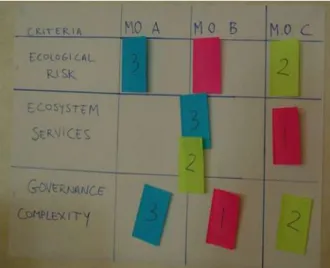
Using Ecosystem State Information in Ecosystem Service Assessments
In this section we describe an assessment approach (MECSA: Marine Ecosystem Capacity for Service Supply Assessment) developed with the European Environment Agency that uses policy-reported ecosystem status information (from the Marine Strategy Framework Directive and reports of other relevant) to assess the present and the future. capacity to provide ecosystem services (Culhane et al. 2020; Culhane et al. 2019a).
Steps to Implementing the Method
Example Case Study: North East Atlantic
We can then look to policy assessments to find information on the status of each of these whale populations in the Northeast Atlantic. So we're assessing what's happening to the whale population in the Northeast Atlantic in general.
Conclusions
6 List of commonly, occasionally or rarely spotted cetacean species advertised by whale watching tour operators (nine tour operators consulted from Ireland, Scotland, England, Portugal and Northern Spain) in the North East Atlantic region. The status of each cetacean species metric reported in each policy for the Northeast Atlantic is given.
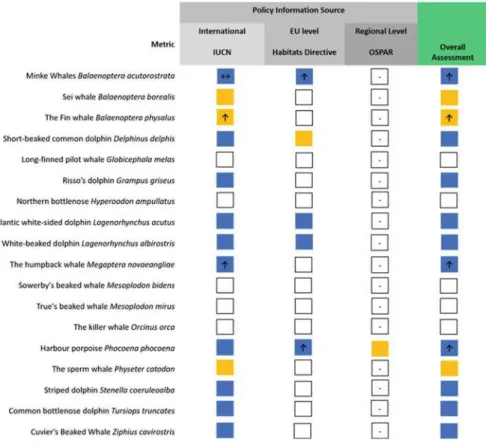
Lessons Learnt
These assessments can inform management of the need for change and adaptation in response to changing supply or demand for ecosystem services. Increasing activities and pressures in the marine environment, in addition to global climate change, require an urgent assessment of how these activities and pressures affect the supply of ecosystem services and what this will mean for long-term sustainability.
Next Steps
DeWitt (Eds.), Ecosystem-based management, ecosystem services and aquatic biodiversity: Theory, tools and practice (pp. DeWitt (Eds.), Ecosystem-based management, ecosystem services and aquatic biodiversity: Theory, tools and applications.
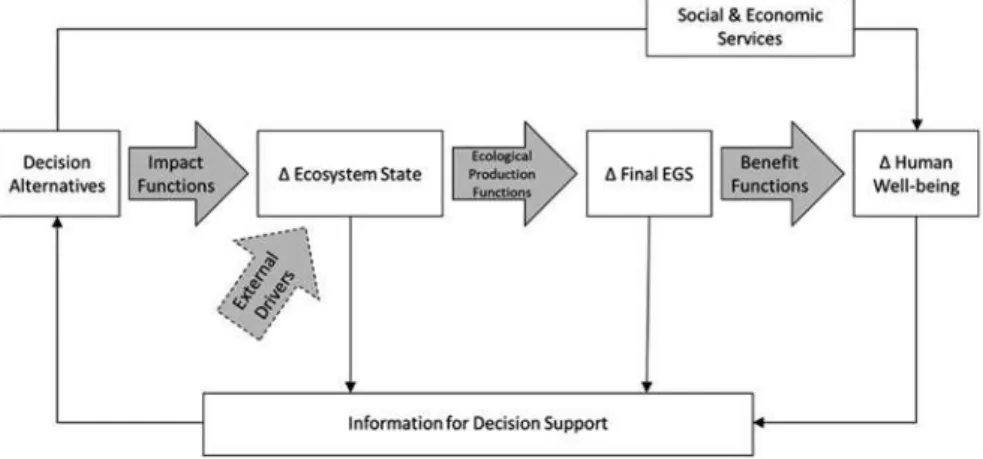
FEGS Classi fi cation System
FEGS Metrics and Indicators
3 Developing FEGS metrics and indicators for a particular environmental type is a six-step process that begins with the beneficiaries and the nature attributes they value. The number of FEGS metrics to measure depends on the problem requirements.

Role of FEGS in Ecosystem-Based Management (EBM)
As close as possible to the FEGS (eg the taxa, size, condition and abundance of game fish, as opposed to the total number of all fish in a location). However, from an operationalizing perspective, analysts, stakeholders or managers may determine that the classification of beneficiaries or ecosystem types (eg for each of the FEGS classification systems) may be too general for the problem at hand.
Integrating FEGS Into a Structured Decision Making (SDM) Framework, and Relevance to EBM
DeWitt (Eds.), Ecosystem-based management, ecosystem services, and aquatic biodiversity: Theory, tools, and applications (pp. 543–560). The supply tables link ecosystem services and products (in rows) to the types of assets they produce (in columns) while the use tables link them to the types of users who use them (in columns). DeWitt (Eds.), Ecosystem-based management, ecosystem services, and aquatic biodiversity: Theory, tools, and applications (pp. 417–430).
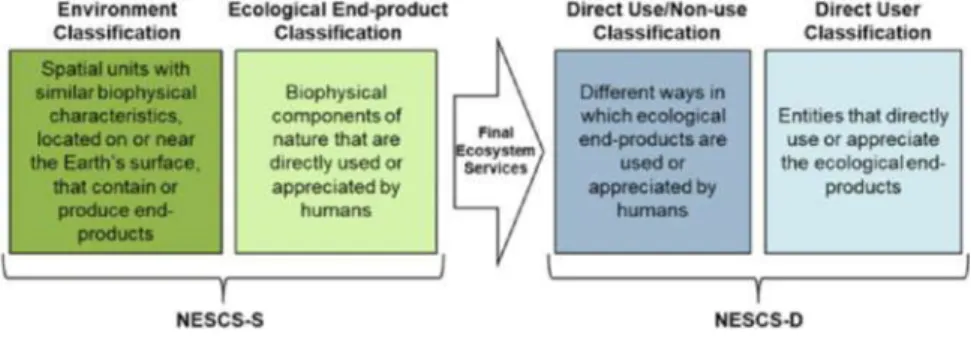
Identifying and Prioritizing Attributes Relevant to Stakeholders
By identifying the most important ecosystem services, the services can be more influential in the decision-making process. This is separate from the question of the relative importance of these criteria (Step 5) for decision makers.
Tiers of the FEGS Scoping Tool
Magnitude of Impact The degree of potential impact on the stakeholder group as a result of the decision. Likelihood of Impact The likelihood of potential impact on the stakeholder group as a result of the decision.
